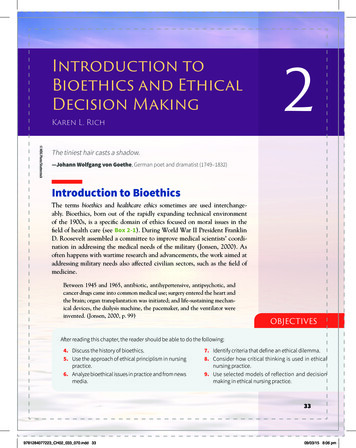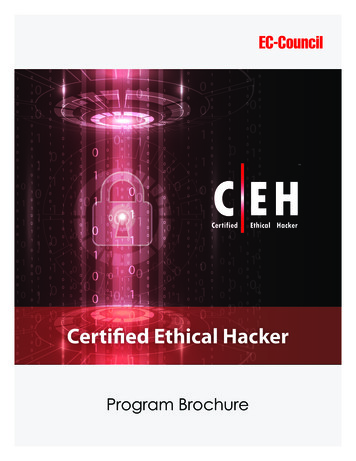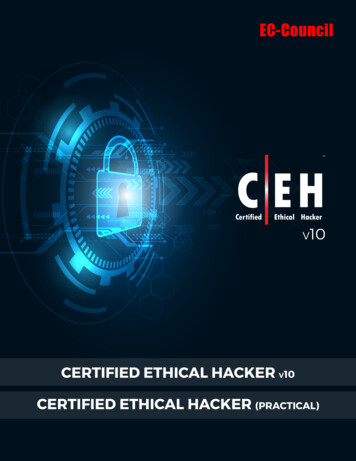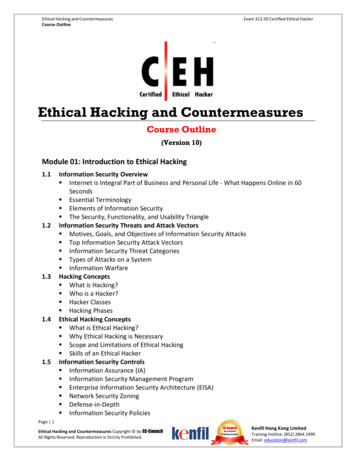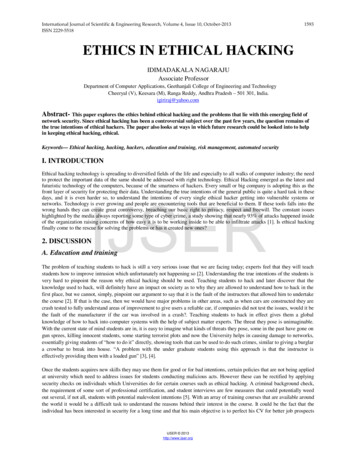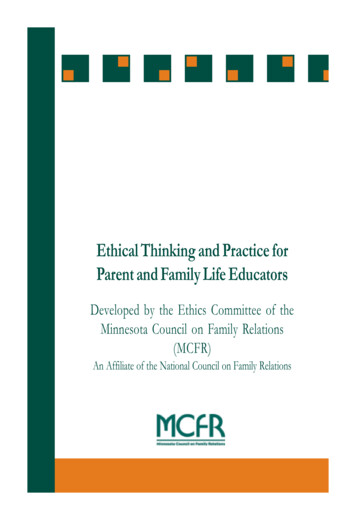
Transcription
Ethical Thinking and Practice forParent and Family Life EducatorsDeveloped by the Ethics Committee of theMinnesota Council on Family Relations(MCFR)An Affiliate of the National Council on Family Relations
Ethical Thinking and Practicefor Parent and Family Life EducatorsDeveloped by the Ethics Committee of theMinnesota Council on Family RelationsEthics Committee Members:Ada Alden, Dawn Cassidy, Betty Cooke,Beth Gausman, Glen Palm, Marietta Rice,Joyce Schultenover, Anne Stokes,Sue Stoner, and Kathy Zanner.Revised by Ada Alden, Dawn Cassidy, Betty Cooke,and Glen Palm, 2009.Minnesota Council on Family Relations2738 Evergreen CircleSt. Paul, MN 55110www.mcfr.netCopyright 2009. All rights reserved. Revised 1/09.Minnesota Council on Family RelationsA PDF of this booklet is accessible via the MCFR website. Contactthe MCFR office if you would like to purchase copies of the booklet.This document serves as the foundation for the National Councilon Family Relations (NCFR) Certified Family Life Educator (CFLE)program Code of EthicsPrinted in the United States of America
Ethical Thinking and Practice for Parent and Family Life EducatorsMinnesota Council on Family Relations (MCFR)IntroductionParent and family life educators face difficult ethical issues on a daily basis.These issues may include observing parenting practices that may be harmfulto children, responding to parent remarks about their partners, or sharinginformation about a family with a professional in another agency. Some ofthese situations may be resolved by reviewing general principles of goodpractice with a colleague, while others may reveal a true ethical dilemma.Parent and family life educators are working with complex family systems,diverse belief and value systems, and a variety of social institutions andagencies. Many face these issues in relative isolation and with limitedguidance from an emerging field. This document was developed to offera thoughtful and balanced approach to understanding ethical principlesand a concrete process for using them to address difficult ethical issuesand dilemmas.HistoryThe information on ethics described here was developed by the EthicsCommittee of the Minnesota Council on Family Relations. This group hasstudied ethical thinking and behavior for parent and family life educatorssince 1992. This journey has involved an initial needs assessment ofMinnesota parent and family life educators, several workshops to developand field test an inductive process for identifying guidelines and virtues forparent and family life educators, and consultation with professionals fromother fields. The process led to new understandings and the developmentof a multi-perspective approach to ethics. The blending of the traditionalethical principles approach with virtues ethics and relational ethics wasan outcome of meetings with Dr. William Doherty, Professor in FamilySocial Science at the University of Minnesota, who has adapted virtuesand relational ethics to the field of family therapy. These three differentapproaches provide different, but compatible, lenses for understandingethical practice. Together they provide a unique approach to ethics forparent and family life education.A second set of workshops was developed to test and refine the integrationof the three approaches and fine tune a case study process for generatingethical thinking and solutions. The guidelines and case study process1
presented here are a result of several workshops during 1995-1997,where practitioners applied the guidelines to case studies. The EthicsCommittee used input from these workshops to edit and refine theprinciples. The ethics process has been shared with both state andnational audiences since then through workshops at local and nationalconferences. NCFR has published this information as part of a resourcebooklet for family life educators.In 2007 the National Council on Family Relations (NCFR) Certified Family Life Educator (CFLE) program went through a transition with theinitiation of an exam as a new criterion for certification. The questionabout adopting an official code of ethics for CFLEs came up during thistime, and the revision of the original MCFR document as a working codeof ethics was proposed as a way to meet this need for CFLEs. A code ofethics provides an additional indicator of professionalism as the CFLEprogram continues to evolve and gain recognition. In 2009 NCFRadopted the MCFR Ethical Principles for Parent and Family Life Educators asthe foundation for an official Code of Ethics for the Certified Family LifeEducator designation. All certification applicants must now sign a statement verifying that they will adhere to the ethical principles.2
Integration of Three Approaches to EthicsThe relational ethics approach provides a starting place for understandingrelationships as the context for making ethical decisions. This perspectiveallows for a careful examination of the multiple relationships that parentand family life educators encounter as a step towards applying principles.Parent and family life education professionals also see it as a guide foraction. Striving for caring relationships in all professional interactions isthe goal of relational ethics. Relational ethics provides a clear understandingof the immediate state of a relationship as well as goals for establishinga caring relationship. It provides both process and content for ethicalbehavior. General principles for developing caring, respectful relationshipswith family members are outlined in the section on Relational Ethics.The principles approach to ethics has been linked to the relational ethicsapproach by organizing principles around the concept of relationships.This allows parent and family life educators as a group to articulateimportant principles that can guide interactions with different populations.The principles are intended to guide parent and family life educators ineveryday decisions and actions.The third approach to ethical thinking involves the more individual lensof virtues ethics. It attempts to fill in a gap in our current way of definingprofessional behavior that tends to focus more on technical competencethan on moral character. Good practice in family life education should betied to internal standards of excellence as well as external behavior. Virtuesare “dispositions to do the right thing for the right reason.”Virtues can be defined on two different levels. The first level identifiescore virtues that are necessary for every profession. These include virtuessuch as justice, truthfulness, and courage. Their implementation variesover time and in specific professions. The second level includes thosevirtues that are essential for ethical practice in the current social contextfor parent and family life education.Three essential virtues have emerged from the discussions between EthicsCommittee members and practitioners:1. Caring: A disposition to enhance the welfare of family members asagents in their own lives.2. Prudence/Practical Wisdom: The ability to understand competingneeds and decisions based on reflection and consultation.3
3. Hope/Optimism: A disposition to look at the strengths of familymembers and other individuals and to see positive potential in situationsrelated to family life.These dispositions provide family life educators with internal strengths tothink and behave in an ethical manner.The strengths of a multi-perspective approach depend not only upon therichness of having different perspectives but also the dynamic tensionsthat keep a balance between absolutism and relativism. The creativetensions in this approach include: (1) a balance between the dynamic natureof relationships and the more static nature of principles; (2) a balancebetween the individual in the context of a relationship and the group inthoughtful reflection of important principles; and (3) a balance betweenwisdom of the past, lessons of the present, and striving to be good in thefuture. These tensions provide a dynamic balance to ethical thinking asit continues to evolve through reflection and refinement.4
Relational Ethics: An IntroductionThe use of relational ethics is critical to work with families. The principlesof relational ethics form a basis for understanding specific ethical dilemmasand guide practice first and foremost towards the development of caringand respectful relationships with all family members. Some of the importantprinciples that assist family life educators towards this end are:1.The parent and family life educator’s relationship with individualfamily members, peers, and the community is both the context andthe point of contact for our ethical thinking and actions. This meansthat parent and family life educators will focus on relationships inunderstanding ethical issues and depend upon the development ofcaring relationships to guide movement towards ethical actions.2. Parent and family life educators bear the primary responsibility toinitiate a relationship built on trust, caring, and understanding. Allrelationships are two-way interactions and parent and family lifeeducators cannot assure that all their relationships will be positive.However, parent and family life educators will model acceptance,caring, and understanding towards family members and peers whilepursuing a mutually respectful and caring relationship.3. All relationships have predictable stages of development. Parent andfamily life educators will adjust their practice to their understandingof the state and stage of a relationship.4. Parent and family life educators will bring a knowledge base of generalprinciples about children and youth, parenting, family, and communitysystems to share with family members. Parent and family life educatorswill work in collaboration with parents to understand how theseprinciples apply to individual family members and situations.5. Parent and family life educators will set boundaries on their relationships with family members and be responsible for potential negativeinfluences of care taking beyond these limits. The intensity of relationships will vary but the good family life educator will be vigilantof his/her responsibility to nurture interdependence between familymembers and other community systems.In many ways the caring and respectful relationships that parent andfamily life educators build with family members are analogous to healthy5
parent-child relationships. Parent and family life educators need to takethe major responsibility for initiating healthy relationships and must workto maintain these relationships. In many cases relationships with adultsquickly assume a stance of mutual respect and understanding. In othercases there may be a number of barriers that make this relationship moredifficult to build into an egalitarian and respectful relationship. Parent andfamily life educators must continue to develop an understanding of therelationship process and how to best facilitate healthy relationshipsamong family members, colleagues, and themselves.6
Ethical Principles for Parent and Family Life EducatorsI. Relationships with Parents and Families1. We will be aware of the impact we have on parents and family relations.2. We will strive to understand families as complex, interactive systemswhere parents have the primary responsibility as educators, nurturers,and limit-setters for their children.3. We will respect cultural beliefs, backgrounds, and differences andengage in practice that is sensitive to the diversity of child-rearingvalues and goals.4. We will help parents and other family members recognize theirstrengths and work with them to set goals for themselves, theirchildren, and others.5. We will respect and accept parents and other family members for whothey are, recognizing their developmental level and circumstances.6. We will support and challenge parents to continue to grow and learnabout parenting and their child’s development.7. We will communicate respectfully and clearly with all family members.8. We will communicate openly and truthfully about the nature andextent of services provided.9. We will support diverse family values by acknowledging and examiningalternative parenting practices that support healthy family relationships.10. We will include parents and other family members as partners inproblem solving and decision-making related to program design andimplementation.11. We will be proactive in stating child guidance principles and disciplineguidelines and encourage non-violent child rearing.12. We will create data privacy and confidentiality guidelines respectfulof family members and protective of their legal rights.13. We will provide a program environment that is safe and nurturing toall family members.14. We will ensure that all family members have access to and areencouraged to participate in family life education.7
15. We will support family members as they make decisions about the useof resources to best meet family needs.16. We will support healthy interpersonal relationships among all familymembers.17. We will encourage parents and other family members to reflect upontheir values regarding sexuality and promote the healthy sexual development and well being of each family member.II. Relationships with Children and Youth1. We will treat children and youth with respect and sensitivity to theirneeds and rights as developing persons.2. We will strive to understand children and youth in the context oftheir families.3. We will do no harm to children and youth and insist on the samefrom others.4. We will advocate for children and youth and their best interests at thesame time that we work with the parents and other family members.5. We will provide environments that are respectful of children andyouth and sensitive to their developmental and individual needs.6. We will support the right of all children and youth to have access toquality education, health, and community resources.III. Relationships with Colleagues and the Profession1. We will value and promote diversity in staff.2. We will provide staff with policies and support systems for addressingdifficult situations with family members, colleagues, and others.3. We will follow data privacy policies that meet legal standards and arebased on respect for family members.4. We will follow the mandatory reporting of abusive family behavior ina respectful and prudent manner.5. We will define our role as parent and family life educators and practicewithin our level of competence.8
6. We will recognize the difference between personal and professionalvalues in our professional interactions.7. We will support the ongoing development of a knowledge base thatguides us towards ethical and effective practice.8. We will be committed to ongoing professional development toenhance our knowledge and skills.IV. Relationships with Community/Society1. We will be knowledgeable about community resources and make andaccept informed, appropriate referrals.2. We will be aware of the boundaries of our practice and knowwhen and how to use other community resources for the benefit offamily members.3. We will communicate clearly and cooperate with other programs andagencies in order to best meet family needs.4. We will advocate for laws and policies that reflect our changingknowledge base and the best interests of parents, families, andcommunities.5. We will respect and uphold laws and regulations that pertain to ourpractice as parent and family life educators and offer expertise to legalauthorities based on professional knowledge.9
CASE STUDY PROCESSIntroduction to Process:This process is provided as one concrete way for small groups of parentand family life educators to carefully examine an ethical dilemma using theapproaches described earlier. It is critical to practice ethical thinking in thisconcrete manner to become familiar with both the principles and the process.This process can be done in approximately one hour as a part of staff meetings.Process Steps:Steps 1 through 3 focus on ethical thinking. This is important; give itplenty of time. Practitioners tend to leap to brainstorming possible actions/solutions before thoroughly engaging in the process.Step 1. Identification of Relationships: Identify important relationshipsin the situation using the educator role as the primary focal point.a. What is the relational field – what are all potential relationships inthe case?b. What is the primary caring relationship the educator needs toaddress in this case? (Examples: educator to family member,educator to group, educator to another staff person)c. What do we know about this relationship – quality, stage ofdevelopment, etc.?Step 2. Identification of Principles: Look over the list of principles toidentify those that apply to the important relationship(s) in this situation.Decide which principles may be relevant to guiding ethical behavior.Are there any additional principles that might apply? Which are the threeor four most relevant principles? Why? (Spend some time alone to selectprinciples before discussing in small group.)Step 3. Identification of Contradictions/Tensions: What are somepotential/actual contradictions or tensions among or between relevantprinciples?Step 4. Identification of Possible Solutions: Brainstorm possible actionsby the parent and family life educator – keeping in mind therelationship(s), the relevant principles, and the virtues.Step 5. Selection of Actions: Select one action or combination of actions touse that reflects adherence to the ethical principles. All of the principles areimportant and should be addressed in a thoughtful and respectful manner.10
APPLICATION OF THE PROCESSTO REAL LIFE DILEMMAS/CASE STUDIESThe following real life ethical dilemma was discussed by a group of parentand family life educators, early educators, and administrators using thecase study process. This scenario illustrates how the case study processcan be applied to make thoughtful decisions about ethical challenges.CASE STUDY EXAMPLE:Culture and Gender Issues in the Early Childhood ClassroomA mother and her son attend an Early Childhood Family Education(ECFE) class for four year olds. They are from Somalia. The mother haslimited English but participates well in the parenting class by listening andtalking at length when asked a question. She is quietly involved with herson during parent-child interaction time. Her son loves the children’s room.He is eagerly involved in most areas of the room, with a clear preferenceand a strong interest in the housekeeping area. During parent-child time,mom steps back when her son enters the kitchen area.At the home visit, the parent educator meets the father and siblings. It isclear that only the father is going to speak with the parent educator, withonly a brief “hello” from the mother. The parent educator is treatedrespectfully and positively. The father says he is thankful that his son is in theclass and he hopes his son will continue to learn English, letters, and numbers.After a few weeks, the father sends a message indicating that his son is notto play in the kitchen area. Household work is not for boys and Somalimales have nothing to do with such activities. There was no discussion ofthe housekeeping area at the home visit.Staff DiscussionThe group began the discussion by jumping immediately to suggestingstrategies, but they were directed back to the process. It is common whenstaff members discuss an ethical dilemma that they want to solve theproblem and look for an immediate solution or action. A true ethical dilemma does not have a quick and easy resolution because important ethical principles are in conflict or tension with each other.Step 1: Identify Important RelationshipsThe group identified that the important relationships were with themother, father, and child. The relationships with the mother and child are11
more established through their regular attendance at the ECFE class.The relationship with the father has been positive but limited to onehome visit. The father appears to be the decision-maker in the family andmaintaining a positive relationship with him will be important.Step 2: Identify Relevant Ethical PrinciplesThe staff identified the relevant principles for this situation in Part I: Relationships with Parents and Families:I.2. We will strive to understand families as complex, interactive systemswhere parents have the primary responsibility as educators,nurturers, and limit-setters for their children.I.3. We will respect cultural beliefs, backgrounds, and differences andengage in practice that is sensitive to the diversity of child-rearingvalues and goals.I.10. We will include parents and other family members as partners inproblem solving and decision-making related to program design andimplementation.I.13. We will provide a program environment that is safe and nurturing toall family members.In Part II: Relationships with Children and Youth, three principles wereidentified.II.4. We will advocate for children and youth and their best interests at thesame time that we work with the parents and other family members.II.5. We will provide environments that are respectful of children andyouth and sensitive to their developmental and individual needs.II.6. We will support the right of all children and youth to have access toquality education, health, and community resources.Step 3: Identify Contradictions/Tensions between PrinciplesThe first proposal was that Principle I.3, respect for cultural beliefs, wouldbe most important. Several people murmured agreement. It then becameapparent that this principle was in conflict with Principle II. 5, providingenvironments sensitive to a child’s/youth’s developmental and individualneeds. No one approved of removing the kitchen area from the environment12
or of restricting the child when others had free choice. Important questions were raised during this discussion of principles. Is this family living here permanently or just for a year of two?Could we leave it to the mother to restrict the child?Is the housekeeping area important and a cultural value for otherfamilies?What other dramatic play areas could there be?There was also discussion that males should be taught to cook and cleanas a matter of self-sufficiency and gender equality. Children learn a greatdeal through the dramatic play in the housekeeping area. In this situationthe staff could help the father to see the benefits of learning that thekitchen play area provided for his son.The staff struggled with the concept and boundaries of cultural respect.Should families from other cultures adapt to American culture and respectthe housekeeping area as an important part of the American preschoolenvironment and curriculum? If American children were attending a Japaneseschool, would we expect them to remove their shoes out of respect for theculture? It was noted that at U.S. military child care centers, the sand tableoften contains tanks, planes, and “Army guys.” This type of play is culturallyrelevant, yet when asked, most of the staff members involved in thisdiscussion would not enroll their child in a program that had a “gun corner”or a learning center that included guns. Cultural values embedded in theenvironment and activities of a preschool became apparent in the discussion.It was clear that some values were important to the staff such as equality,respect for household tasks, and respect for cultural differences and thatthey were in conflict or tension in this particular situation.These questions helped the group see the potential contradictions andtensions between principles. Many staff members wanted to say thatprotecting culture was the most important principle. They were sensitiveto the issue of people being asked to deny their culture. They valueddiversity and respected families’ differences. However, when they had todefend the strategies that using only Principle 1.3, respect for culturaldiversity, would entail, they realized that their primary goal was to providea diverse and responsive environment for children. This included allowingchildren free choice, responding to children’s interests, and teaching children13
about “real life.” Understanding the tensions between these two principlesset the stage for considering possible solutions.Step 4: Identify Possible SolutionsAs the staff discussed strategies and implications, the following questionarose: If we are unable to assist the family in becoming comfortable withour curriculum, is taking the stance we have chosen worth the risk oflosing the child from the program?The following strategies were proposed: Discuss with the family about what children learn through thehousekeeping area. Indicate that this is the area that consistentlyhas the most social interaction. This may be particularly good fortheir son’s development of language.Make a strong statement that one of our goals is to be respectfulof family culture. Let the family know that staff would never insistthat the child play in that area.Ask the parents if they had ideas on how to resolve this situation.Inform the parents that their son would be observed to see whataspect of the housekeeping area he seemed to be most interestedin and then try to offer different play settings that would addressthose interests.Inform the parents that the kitchen area would not always be partof the classroom. The staff said they could be comfortable withthe kitchen area being absent one-third to one-half of the year.Thank the parents for bringing this dilemma to staff and givingthem the opportunity to consider the issue. Explain that this wasa learning experience for all the staff in understanding differentcultural values.Step 5: Select an Action(s)This case led to selecting a number of the identified options to implement.The first was to talk to the parents about the issues and see if they hadideas for resolving the situation. The early childhood teachers would addnew dramatic play props to transform the housekeeping area into a varietyof different dramatic play opportunities for the children. Discussing withthe parents about what children learn through the dramatic play and whythe housekeeping area is part of the environment was the final action thestaff would take.14
PRACTICE CASE STUDIESThe following case studies are presented as examples for practitioners touse to practice the process on their own.Case Study 1: Mother, Daughter, Father DilemmaIn one mother-child pair in your class for toddlers and their parents, thetoddler has several developmental delays and the mother has some, too.The mother alludes to the father being abusive. In talking with others whodeal with the mom, you have been made aware of the dominance of thefather and his family. How can you support the mom and daughter without causing upset in the family relationships? You have been told that thefather will pull the family from any support if he feels threatened. Whatdoes the “good” family life educator do?Case Study 2: Twin DilemmaAs a parent educator for an Early Childhood Family Education class youmeet with colleagues in early childhood special education who tell you about afamily with twins. One of the twins is a child with typical developmentalneeds; the other is a child with Down syndrome. The early childhood special education staff feels that the child with Down syndrome would bebest served at home with services provided by special education staff. Thestaff is focused on best practices for the child in need of their expertise,special education. The special education staff recommends the motherbring only the typically developing child to class.You agree that the child with Down syndrome would be best served within-home services. You also think the mother should be allowed to bringboth children to the regular ECFE parenting class. The special educationstaff does not think that is necessary. However, you see that the family isa system and recognize that this is a mother of two children and a familyof four to consider. What does the “good” family life educator do?Case Study 3: Father and Child Custody DilemmaA father who has attended your parent education program for eight weekscalls to talk to you about his children and their mother. He and the children’smother are not married, and he has recently moved out after living togetherwith the children and their mother for five years. He wants you to testifyon his behalf at a custody hearing. He tells you that his children’s momworks late hours and is rarely home. She pieces together the care for thetwo-year-old and four-year-old with her friends. He worries about the15
children’s safety and does not think that she is a fit mother. He attendedyour program faithfully with both children and appeared to be a warm andcaring parent based on your observations of his interactions with his twochildren. You have never met the mother and only know about her fromthe father’s description. What should the “good” family life educator do?Case Study 4: Early Intervention and Culture DilemmaAn early interventionist begins working with an 18 month old infant whowas born two months early and has qualified for services because of developmental delays. Both parents are deaf and communicate through signlanguage. The early intervention team is concerned about language delaysand wants to provide a speech and language therapist for the child. Theparents are refusing these services because they want their child, who isnot hearing impaired, to grow up in the deaf culture that they value. Theyare requesting that the early intervention staff only communicate withtheir child through sign language. The early intervention practitioner isconcerned that the child may miss the opportunity to develop spokenlanguage if the child has such limited exposure to oral language during thiscritical period for language development. What should the “good” familylife educator do in this situation?Case Study 5: Gay
This allows parent and family life educators as a group to articulate important principles that can guide interactions with different populations. The principles are intended to guide parent and family life educators in everyday decisions and actions. The third approach to ethical thin
